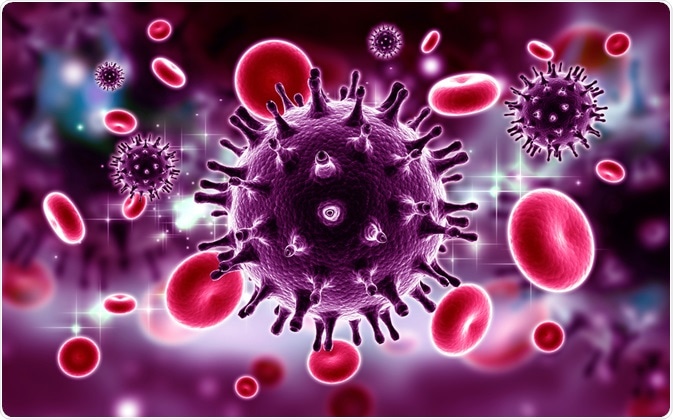How is the HIV Epidemic Being Controlled?

The human immunodeficiency virus (HIV) is a pathogen that weakens the immune system by targeting CD4 cells, which are responsible for playing a pivotal role in the body’s response to infections.

Image Credit: RAJ CREATIONZS/Shutterstock.com
HIV is a retrovirus that belongs to the lentivirus subgroup, which is known to cause disease slowly. Without adequate disease control, HIV-infected CD4 cells are gradually killed overtime, and as a consequence, the body’s ability to recognize and respond to immunogenic threats declines. This can ultimately lead to the development of acquired immunodeficiency syndrome (AIDS).
HIV infection is considered to be AIDS when the number of CD4 fighter cells drops below 200 and/or there is a mounting number of opportunistic infections regardless of CD4 count. Without treatment, the typical life expectancy, once an individual has developed AIDS, is 3 years or less.
Fortunately, great strides have been made concerning understanding and controlling HIV since its discovery in the 1980s. As a result, medication may halt disease progression and can be lifesaving before the development of AIDS. Thus, control is centered largely on education/ prevention in the first instance, and testing for early recognition and treatment, where applicable.
Epidemiology of HIV
There are over 75 million people who have been infected with HIV since the onset of the epidemic and approximately 32 million people have lost their lives to the virus. At the beginning of 2019, at least 38 million people were living with HIV around the world.
The hardest-hit regions are seen on the African continent.
Although the virus is largely preventable through concerted public health measures, the epidemic in the European region remains mostly unchanged. There are approximately 30, 000 new diagnoses in the EU/EEA annually.
HIV treatment
The mainstay of treatment for HIV is antiretroviral therapy (ART), and this usually involves a daily combination of drugs. While ART is not a cure for HIV, it allows for those infected to live near-normal lifespans with less disease burden.
Moreover, it suppresses the amount of HIV in the blood (i.e. viral load) to levels that make transmission less likely. The sooner an infected individual starts taking ART, the better the prospects for management. This is why it is of paramount importance for individuals at risk to get tested and to do so regularly.
ART works by blocking HIV from infecting healthy CD4 cells. Although it eventually kills these cells, HIV needs CD4 cells to replicate. While ART does not completely clear HIV from the body, the inability to replicate reduces the viral load, and thus gives the immune system a chance to produce more CD4 cells to ward off infection and HIV-related malignancy. Furthermore, an undetectable viral load means that infected individuals cannot transmit HIV to their non-infected partners.
There are several drug classes of ART, namely non-nucleoside reverse transcriptase inhibitors (NNRTIs), nucleoside reverse transcriptase inhibitors (NRTIs), CCR5 antagonists, fusion inhibitors, integrase strand transfer inhibitors (INSTIs) and post-attachment inhibitors. These drugs are classes based on their mechanisms of action as they interact with HIV, which is given in their names. They attack the virus at varying stages in its life cycle, ultimately preventing it from propagating itself.
Drug choice and/or combination is determined on an individual basis and takes into account several factors, such as resistance, side-effects, and the possibility of interaction between other medications an individual may be on.

Image Credit: Maxim Ermolenko/Shutterstock.com
HIV prevention
Efficient HIV public health campaigns are centered around evidence-based prevention programs for targeted groups deemed at risk. Historically, groups most at risk are intravenous drug users, men who have sex with other men, and immigrants from countries hardest hit with the epidemic.
Public health campaigns that promote simple strategies, such as abstaining from sex, proper condom use, and refraining from intravenous drug practices, are effective in preventing HIV. Moreover, people are encouraged to limit their number of sexual partners.
Thanks to our evolution in the understanding and management of HIV, there is also now access to pre-exposure prophylaxis (PrEP) and post-exposure prophylaxis (PEP), which are strategies to decrease the chances of HIV acquisition before or after possible exposure, respectively. PrEP if taken daily and consistently, has been shown to reduce the chance of acquiring HIV by 99% through sexual contact, and by 74% through intravenous drug use.
In contrast, PEP is used under emergency circumstances if there has been a possible exposure to HIV. For example, condom breakage during sex with a random sexual contact whose HIV status is unknown, or accidental injury with direct blood to blood contact with a person whose HIV status is also unknown.
PEP should be taken within 72 hours of possible exposure – the sooner it is taken, the better. Once prescribed, it is taken for at least 4 weeks and is considered to significantly reduce the chances of developing HIV after potential exposure to the virus.
Sources
- http://hivinsite.ucsf.edu/InSite?page=ar-drugs-about
- https://www.ncbi.nlm.nih.gov/books/NBK11782/
- www.mayoclinic.org/…/drc-20373531
- https://ourworldindata.org/hiv-aids
Last Updated: Jul 6, 2020

Written by
Dr. Damien Jonas Wilson
Dr. Damien Jonas Wilson is a medical doctor from St. Martin in the Carribean. He was awarded his Medical Degree (MD) from the University of Zagreb Teaching Hospital. His training in general medicine and surgery compliments his degree in biomolecular engineering (BASc.Eng.) from Utrecht, the Netherlands. During this degree, he completed a dissertation in the field of oncology at the Harvard Medical School/ Massachusetts General Hospital. Dr. Wilson currently works in the UK as a medical practitioner.
Source: Read Full Article